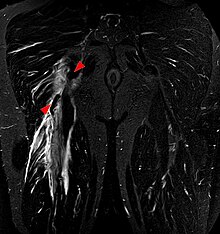Hamstring
| Hamstring | ||
|---|---|---|
Antagonist Rectus femoris muscle | | |
| Identifiers | ||
| MeSH | D000070633 | |
| Anatomical terms of muscle] | ||
In human anatomy, a hamstring (
Etymology
The word "ham" is derived from the Old English ham or hom meaning the hollow or bend of the knee, from a Germanic base where it meant "crooked". It gained the meaning of the leg of an animal around the 15th century.[5] String refers to tendons, and thus, the hamstrings are the string-like tendons felt on either side of the back of the knee.[6]
Criteria
The common criteria of any hamstring muscles are:
- Muscles should originate from ischial tuberosity.
- Muscles should be inserted over the knee joint, in the tibia or in the fibula.
- Muscles will be innervated by the tibial branch of the sciatic nerve.
- Muscle will participate in flexion of the hip joint.
Those muscles which fulfill all of the four criteria are called true hamstrings.
The
Structure
The three muscles of the posterior thigh (semitendinosus, semimembranosus, biceps femoris)
| Muscle | Origin | Insertion | Nerve |
semitendinosus |
ischial tuberosity | medial surface of tibia | tibial part of sciatic |
semimembranosus |
ischial tuberosity | medial tibial condyle |
tibial part of sciatic |
biceps femoris - long head |
ischial tuberosity | lateral side of the head of the fibula |
tibial part of sciatic |
biceps femoris - short head |
lateral supracondylar line of femur |
lateral side of the head of the fibula (common tendon with the long head) |
common peroneal
|
A portion of the
Function
The hamstrings cross and act upon two joints – the hip and the knee – and as such they are termed biarticular muscles.
Semitendinosus and semimembranosus extend the hip when the trunk is fixed; they also flex the knee and medially (inwardly) rotate the lower leg when the knee is bent.
The long head of the biceps femoris extends the hip, as when beginning to walk; both short and long heads flex the knee and laterally (outwardly) rotate the lower leg when the knee is bent.
The hamstrings play a crucial role in many daily activities such as walking, running, jumping, and controlling some movement in the
Clinical significance
Sports running injuries
A common running injury in several sports, excessive stretch of a hamstring results from extensive
Imaging


Imaging the hamstring muscles is usually performed with an
Use in surgery
The distal semitendinosus tendon is one of the tendons that can be used in the surgical procedure ACL reconstruction. In this procedure, a piece of it is used to replace the anterior cruciate ligament (ACL). The ACL is one of the four major ligaments in the knee, which also include the posterior cruciate ligament (PCL), medial collateral ligament (MCL), and lateral collateral ligament (LCL).
See also
References
- ^ "University of Glasgow - Schools - School of Life Sciences". www.gla.ac.uk.
- ^ "Biceps Femoris - Short Head — Musculoskeletal Radiology — UW Radiology". Rad.washington.edu. Retrieved 2012-11-02.
- ^ Mayo Clinic Staff (3 Oct 2015). "Hamstring injury". Mayo clinic. Retrieved 6 July 2016.
- ^ PMID 32993700.
- ^ Brown, Lesley, ed. (2007). Shorter Oxford English Dictionary II (Sixth ed.). Oxford: Oxford University press. p. 3611.
- ^ "Online Etymology Dictionary". Etymonline.com. Retrieved 2012-11-02.
- ^ a b postthigh at The Anatomy Lesson by Wesley Norman (Georgetown University)
- ^ S2CID 139106410.
- S2CID 23597752.
- S2CID 23953024.
- S2CID 174755.
